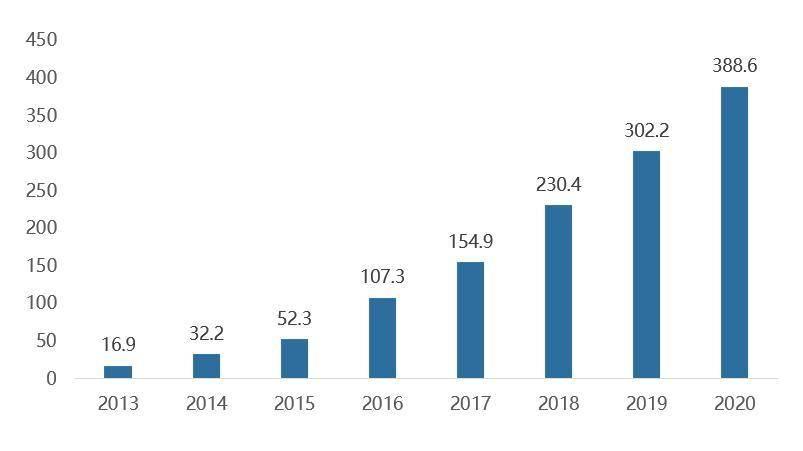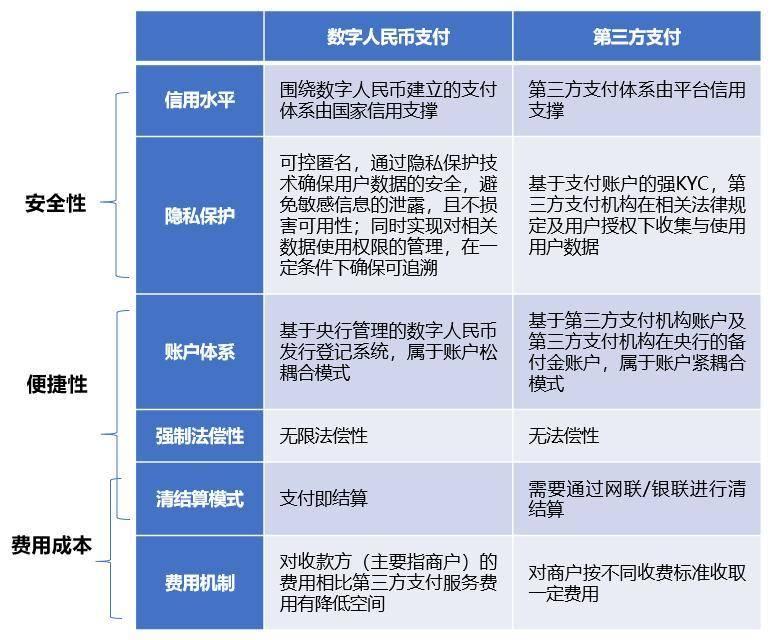数字人民币与支付宝等第三方支付究竟是什么关系?
本文发布于01区块链,作者:泽玲、雨林。
5 月 10 日,#数字人民币与微信支付宝关系# 话题登上了微博热搜榜。

央行数字货币研究所所长穆长春曾表示,微信、支付宝和数字人民币不是一个维度上的,微信和支付宝是钱包,数字人民币是钱包里面装的钱。腾讯、蚂蚁各自的商业银行属于运营机构,因此和数字人民币不存在竞争关系。
01 区块链就该话题曾做过一番深入探讨,我们将相关内容再次发布,希望能帮助读者更好地了解数字人民币。
现阶段,数字人民币(DC/EP)研发试点工作正在稳步推进中。数字人民币是数字形态的法定货币,同时又是一种电子支付手段,其发行推广将对我国支付体系,特别是对支付宝、财付通(微信支付)为代表的第三方支付平台带来深远影响。
数字人民币本质上与第三方支付并不存在冲突,前者是「钱」,是数字形式的法定货币;后者是「钱包」,是货币的支付运行设施和体系、方式,是为货币的流通服务的。因此,从严格意义上来讲,数字人民币与支付宝、财付通等第三方支付并不存在竞争关系。
不过,从数字人民币的试点工作来看,其在零售支付场景的使用过程中,无论是依凭的支付终端还是支付体验,都与现有的第三方支付在诸多方面存在重合。同时,使用数字人民币进行支付相较于第三方支付,在安全性、便捷性、费用成本等方面都存在相对优势,其中费用成本的优势或成为冲击第三方支付的关键因素,对第三方支付平台造成流量挤压,并进一步冲击衍生业务。
然而,具体的影响程度还要看数字人民币的推广速度和力度。考虑到数字人民币在发行推广前期,重心主要在用户习惯培养以及场景开发上,因而对第三方支付的影响可能并不明显。同时,第三方支付机构参与数字人民币运营体系的深度让相关影响也存在诸多变数。
不过,在受到数字人民币可能带来的冲击同时,第三方支付依靠自身的技术实力和数据积累也可能在数字人民币钱包开发、用户体验提升以及数字人民币的跨境支付探索等领域寻找到新的机遇。
一、数字人民币 vs 第三方支付:「钱」与「钱包」,两者非竞争关系
数字人民币:作为「钱」的电子支付手段
数字人民币(DC/EP,全称:Digital Currency Electronic Payment)是由中国人民银行发行的数字形式的法定货币,是一种电子支付手段,主要定位为 M0,即流通中的现金;在实际的使用中,主要用于小额高频零售场景。(进一步了解,参见《数字人民币概述:属性、历程、动因及目标》)
数字人民币的系统设计有以下 5 个要点:[1]
- 由中国央行统一发行,坚持中心化管理;
- 采用「央行——商业银行」双层运营模式;
- 以广义账户为基础,支持银行账户松耦合功能;
- 数字人民币定位为央行向公众提供的公共产品,不计付利息,不收取交易手续费;
- 支持可控匿名、双离线支付。
在上述 5 个方面的设计要点中,第 4 点说明了数字人民币是央行向公众提供的一种公共物品,是不计息不收取手续费的「现金」。综合来看,数字人民币具有高度权威与安全性,同时融合了现金和现有电子支付工具的便捷性,并实现了可控匿名功能,兼顾了对用户隐私的保护。
第三方支付:作为「钱包」的电子化支付渠道
根据中国人民银行于 2010 年颁发的《非金融机构支付服务管理办法》,第三方支付是指非金融机构作为收、付款人的支付中介所提供的网络支付、预付卡发行与受理、银行卡收单以及中国人民银行确定的其他支付服务。

图:央行许可的第三方支付业务分类,资料来源:《非金融机构支付服务管理办法》
第三方支付机构在支付体系中主要扮演的是中介服务的角色,主要的盈利模式是收取支付服务费用和交易手续费。第三方支付凭借其支付便捷性和在用户体验、产品创新等方面的优势,已成为我国零售支付领域最主要的支付方式,特别是以支付宝与微信支付为代表的移动支付,凭借丰富的场景优势和完整的服务生态,已经渗透到消费者日常生活的方方面面,成为零售场景重要的金融基础设施。
但需要明确的是,充当支付手段只是货币的一项重要职能。各类支付工具一定程度上虽然也可被视为货币的不同载体或表现形态,货币和支付工具在信用支撑、支付即时性、与账户的依存关系、法偿性等方面都存在较大差异。理解数字人民币,首先要明确其本质上是一类货币,是人民币的数字化,是我国现有法定货币体系的组成部分。
简言之,第三方支付是电子化的支付渠道 / 方式,相当于一个「钱包」,而数字人民币作为一种电子支付工具,相当于钱包里的「钱」。从本质上来说,两者并不存在竞争或替代关系。
但在所依凭的支付终端和支付体验方面,数字人民币与现有第三方支付存在诸多方面的重合,还是可能对现有的第三方支付产生诸多影响。
二、挑战:费用成本优势或成影响第三方支付的关键
移动支付引领第三方支付发展,市场呈现寡头格局
第三方支付已成为我国支付体系特别是电子支付体系中的关键一环。过去数年,第三方支付的交易规模呈现持续增长的态势。

图:2013-2020 年第三方支付综合支付交易规模(单位:万亿元),资料来源:中国产业信息网
根据中国人民银行发布的《2019 年支付体系运行总体情况》,2019 年,银行共处理电子支付业务 2233.88 亿笔,与之相比,非银支付机构的网络支付业务业务处理量已达 7199.98 亿笔。
随着移动互联网、4G、5G 网络的快速发展以及智能手机的普及,线下扫码支付、NFC 等支付方法开始推广应用,移动支付规模大幅增长,并占据了较大市场份额。截至 2019 年末,移动支付交易总体规模占比已经增至 62.8%[2],已经成为第三方支付业务的主要增长点。
而在移动支付市场,支付宝和财付通(微信支付)瓜分了大部分的市场份额。数据显示,截至 2020 年第二季度,在第三方移动支付市场,支付宝和财付通(微信支付)的市场份额占比分别为 55.6% 和 38.8%[3],合计有 94.4% 的移动支付市场份额由两大平台瓜分 。
数字人民币支付体系相对现有第三方支付体系的比较优势
虽然从本质上来说,数字人民币(「钱」)与第三方支付(「钱包」)不具有可比性,但围绕数字人民币钱包建立起的支付体系是可以与现有第三方支付体系加以比较的。

表:数字人民币支付与第三方支付的比较,资料来源:01 区块链、零壹智库
数字人民币的支付相较于第三方支付在安全性、便捷性、费用成本等方面存在一定的比较优势。
安全性
主要体现在支撑支付体系的主体信用水平以及对支付数据隐私的保护。
首先,数字人民币与现有第三方支付体系的信用水平不同,现有第三方支付体系由平台的商业信用支撑,而数字人民币则由国家信用支撑。
其次,从支付数据隐私保护来看,数字人民币基于加密技术实现「可控匿名」,通过隐私保护技术确保用户数据的安全,避免敏感信息的泄露,且不损害可用性;同时实现对相关数据使用权限的管理,在一定条件下确保可追溯,只有央行可获取全量用户身份信息与交易流水。而现有的第三方支付在提供服务时,需要基于支付账户进行强 KYC,第三方支付机构可以在相关法律规定及用户授权下收集与使用用户数据。
便捷性
包括账户总耦合设置以及融合了包括双离线支付在内的多种支付技术带来的便捷性。
数字人民币以广义账户体系为基础,实现银行账户的松耦合,即对于不使用第三方支付工具、没有银行账户的公众而言省去了不少限制,从这个角度来看,数字人民币可以覆盖更广泛的人群。
此外,数字人民币将能融合现有的多种电子支付方式和技术来进行支付,同时基于其作为国家法定数字货币的法律效力,能打破现有第三方支付渠道相互不兼容的现象。而双离线支付功能的实现,也可以满足在极端环境(信号不佳、没有网络)下进行支付交易的需求。
费用优势
现有的第三方支付服务体系中,商户、消费者在交易支付时必须通过第三方支付、网联、银联等中介机构,会产生相应的费用。数字人民币体系直连央行,实现支付即结算,省去了中间环节,对消费者并不收取任何费用,对商户而言,意味着存在服务费用降低的空间,因而更有吸引力。
三、聚焦:数字人民币可能的费用优势对第三方支付的影响
「断直连」后的第三方产业变局
2017 年 8 月,央行支付结算司印发《关于将非银行支付机构网络支付业务由直连模式迁移至网联平台处理的通知》,明确要求「自 2018 年 6 月 30 日起,支付机构受理的涉及银行账户的网络支付业务全部通过网联平台处理」,此即所谓的第三方支付「断直连」。
「断直连」直接改变了第三方支付产业的直连结构、监管方式、盈利模式和未来发展方向。「断直连」以前,第三方支付机构可以直连商业银行,并且往往在多个商业银行开立备付金账户。备付金是第三方支付机构为办理客户委托的支付业务而实际收到的预收待付资金。这些资金所有权属于用户,以第三方支付机构名义存放在商业银行,并由第三方支付机构向商业银行发起资金调拨指令。备付金利息理论上应该由用户所有,但实际上一般由第三方支付机构所有,并构成第三方支付机构的重要收入来源。特别是,相当部分的备付金以同业协议存款形式存放在商业银行,利率比较高。第三方支付机构通过这些备付金账户办理跨行资金清算,超范围经营,变相行使中央银行或清算组织的跨行清算职能。
2018 年 6 月 29 日,央行发布了加急文件,要求从 2018 年 7 月 9 日起,按月逐步提高第三方支付机构客户备付金集中交存的比例,至 2019 年 1 月 14 日实现 100% 交存,第三方支付机构「断直连」的内涵扩大。
「断直连」以后,第三方支付的营收主要来源于支付服务费用,以及基于流量优势的衍生业务。对第三方支付机构而言,他们目前的护城河在于流量、场景和生态。
可能的变局:数字人民币支付体系带来的冲击
围绕数字人民币形成的支付体系最有可能冲击和蚕食的正是第三方支付的流量和场景,并进而对其服务费用收入和衍生业务产生影响。数字人民币作为一种电子支付手段,对第三方支付的潜在影响和冲击不可忽视。
- 流量挤占及中介服务费用收入的降低
数字人民币是央行负债,直接与央行清结算系统连接,由于其不依赖账户,完成货币权属转移即可完成支付全流程,所以具备「支付即结算」特性;另外,作为一种公共物品,数字人民币的投放和流通可以是免费的,这些都使其在提高效率的同时也降低了用户交易成本。而目前第三方支付机构在支付时由于信息流与资金流无法瞬时同步,只能先完成记账过程,之后再通过清结算完成资金转移,虽然用户使用时并不会感受到时间差,但还是与「支付即结算」的数字人民币存在效率差;而作为一种商业服务,第三方支付所提供的支付服务是收费的,这类机构的主要收入来源也正在于提供支付中介服务而收取的服务费用。
从今年深圳罗湖区数字人民币红包试点来看,商户端在收到数字人民币之后,可以实时将数字人民币免费转入其关联的结算户。这相当于将作为现金的数字人民币,直接变成银行卡中的存款。不仅省去了此前收现金之后跑到银行存钱的时间,还节省了从支付宝、微信支付中提现的手续费,因此对商户来说有比较强的动力接入数字人民币收款服务。如果越来越多的商户开始支持数字人民币,那么数字人民币在多个应用场景下的推广和使用或许会对第三方支付平台的流量形成蚕食,进而导致第三方支付机构的支付服务费用收入下降。
- 基于数字人民币的支付衍生业务或成为抢占支付高地的关键
从现有第三方支付业务模式来看,基于由支付业务带来的流量、数据和场景优势,第三方支付平台往往会通过向用户提供衍生服务来获得其他收入。
这些衍生服务可以分为两大类,一类是金融服务,包括借贷、理财等服务。该类业务主要基于第三方支付平台的流量优势,与相关的金融机构合作,起到渠道导流的作用,并从中获得分润。另一类是基于支付平台积累的用户支付行为大数据等衍生出来的征信、风控等相关业务,如支付宝面向用户推出的芝麻信用分以及蚂蚁集团主打风控服务的产品「蚁盾」。
数字人民币的发行推广,在应用场景探索和用户基数上需要一定时间的积累,因此在短期内可能不会对第三方支付产生明显影响。但随着一部分数字人民币运营主体(主要是商业银行)用户基数的增加以及应用场景的下沉,如果在此基础上拓展衍生业务,或许会在一定程度上成为抢占支付业「高地」的关键。
- 与数字人民币相关的运营数据管理路径尚不清晰成为重要变数
目前通过第三方支付平台进行的支付,详细的数据基本由平台留存管理,并且成为平台有针对性地服务客户的重要依据。而与数字人民币相关的流通数据如何在运营机构间被管理尚不明确,因此数字人民币数据管理路径的不清晰也成为运营机构在支付领域实现差异化竞争的一个重要变数。
不过从目前已知的信息来看,首先央行掌握全量数据,并且可以通过数字人民币的运营数据做相应的政策调整;其次,运营机构(大部分为商业银行)可能会留存与数字人民币相关的流通数据,也可能无法留存数据而只是作为数据传输的中转,并且数据最终要与央行做对接。
不过只要数据可以在运营机构处留存,哪怕采用的是加密方式传输和留存,也并不影响运营机构所能提供的个性化服务。但目前央行层面对数字人民币的数据如何被管理所透露的信息较少,我们也只能认为这是目前运营机构能否在支付市场差异化竞争的不确定性所在。
四、第三方支付产业于变局下的机遇
数字人民币的发行虽然可能会为第三方支付产业带来诸多不确定性,但第三方支付服务商在变局下依然可以依靠自身长期以来的积累抓住诸多机会。
首先是第三方支付机构可以依靠自身的技术积累为数字人民币提供钱包开发服务。数字人民币的兑换、支付、管理等都需要数字钱包的支持,因此钱包在数字人民币的支付体系中处于核心地位,第三方支付机构在掌握了数字人民币钱包开发标准的前提下可以依靠自身在支付账户开发中的技术积累做技术迁移,不仅可以为自身的数字人民币运营做技术支持,也可以向其他数字人民币运营机构提供钱包技术支持。
其次是第三方支付机构可以在已经积累的用户数据(尤其是用户行为数据)基础上,注重对用户体验提升的挖掘。数字人民币的前期推广关键之一就是用户体验,如果第三方支付机构可以做好数字人民币的用户使用体验,那么依然可以为平台留存相当数量的用户。
再次是第三方支付机构本身在场景覆盖面上存在优势,数字人民币的前期推广可能依然需要这些机构的场景支持,第三方支付机构未来需要处理好与其他数字人民币运营机构的场景合作与差异化竞争。
最后,部分第三方支付机构已经在跨境支付领域有了诸多实践,数字人民币目前的试点工作虽然还不涉及跨境支付,但未来不排除为人民币国际化而需要相关探索,第三方支付机构可以结合自身的相关经验积累为此做好准备。
注释
[1] 范一飞:关于数字人民币 M0 定位的政策含义分析,中国金融新闻网
[2] 数据来源:国盛证券
[3] 数据来源:艾瑞咨询











